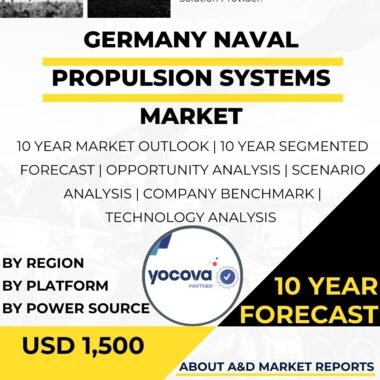Description
The South Korea naval propulsion systems market is a critical component of the country’s defense industry, providing advanced propulsion technologies for its naval vessels. Naval propulsion systems are vital for powering various types of ships, including frigates, destroyers, submarines, and aircraft carriers, enabling them to operate efficiently, maintain high speeds, and execute a wide range of missions. South Korea’s focus on indigenous development, strategic partnerships, and technological innovation has positioned it as a major player in the global naval propulsion systems market.
Naval propulsion systems are crucial for maintaining the mobility and effectiveness of South Korea’s naval fleet. These systems provide the necessary thrust and power to propel vessels through the water, ensuring they can navigate various sea conditions and execute missions effectively. The performance and capabilities of naval propulsion systems directly impact a vessel’s speed, endurance, and operational range, which are critical factors for a nation with significant maritime interests.
Indigenous development has been a cornerstone of South Korea’s defense strategy, and the naval propulsion systems market is no exception. The country’s defense industry, represented by companies such as Hyundai Heavy Industries and Daewoo Shipbuilding & Marine Engineering (DSME), has made significant progress in developing advanced naval propulsion systems tailored to meet the specific requirements of the South Korean Navy.
One of the key indigenous naval propulsion systems in South Korea’s inventory is the CODAD (Combined Diesel and Diesel) propulsion system. CODAD systems are commonly used in frigates and destroyers, and they combine multiple diesel engines and propellers to provide power and flexibility. The CODAD propulsion system allows vessels to achieve high speeds for rapid response while also maintaining fuel efficiency for extended endurance.
Beyond domestic requirements, South Korea actively seeks strategic partnerships with international defense and technology companies to enhance its naval propulsion capabilities. Collaborations with global manufacturers enable technology transfer, joint research, and the integration of foreign propulsion systems into South Korea’s indigenous naval platforms. These partnerships contribute to the continuous improvement of South Korea’s naval propulsion technology and reinforce its position in the global defense market.
Moreover, South Korea’s commitment to innovation and research and development (R&D) has driven advancements in naval propulsion technology. The country invests in R&D programs to improve the performance, fuel efficiency, and reliability of naval propulsion systems. Technological improvements focus on enhancing the power-to-weight ratio, reducing emissions, and integrating hybrid and electric propulsion technologies for enhanced stealth and sustainability.
As part of its broader defense industry, South Korea’s naval propulsion systems market extends beyond domestic needs. The country actively exports naval propulsion systems and related technologies to other nations, generating revenue and expanding its influence in the global defense market. Successful exports demonstrate the reliability and performance of South Korean-made naval propulsion solutions, contributing to the growth of its defense industry.
To ensure optimal utilization and proficiency in operating naval propulsion systems, South Korea places significant emphasis on training and skill development for its naval personnel. Training programs focus on familiarizing crews with the operation, maintenance, and effective utilization of naval propulsion systems in various operational scenarios.
Moreover, cybersecurity is a significant consideration in the naval propulsion systems market, as these systems often incorporate digital components and may be vulnerable to cyber threats. South Korea invests in robust cybersecurity measures to protect its naval assets and ensure the safety and security of naval propulsion operations.
In conclusion, the South Korea naval propulsion systems market is a critical aspect of the country’s defense capabilities. Indigenous development, strategic partnerships, and innovation have allowed South Korea to create advanced naval propulsion systems that meet the specific needs of its naval forces. From powering frigates, destroyers, and submarines to enhancing mobility and operational endurance, these propulsion systems play a vital role in South Korea’s maritime security and power projection capabilities. As the defense industry continues to evolve, South Korea’s dedication to advancing its naval propulsion technology will remain essential in maintaining its maritime superiority and strengthening its position as a major player in the global naval propulsion systems market.




